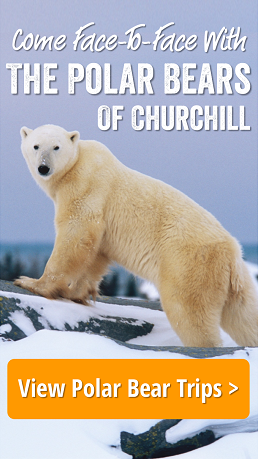by Steve Selden | Feb 13, 2017 | Videos
Traveling from Winnipeg to Churchill to experience the incredible natural wonders found in the frontier town has limited options. You can, of course, fly via the small airlines and hope the weather provides a window in and out of Churchill. You cannot drive, unless you have ample time and are on a four wheeler or a dogsled…closest you can get is Thompson or a bit farther on gravel road. In fact, my favorite mode of travel is by train.
When I guided Churchill Summer beluga whale adventures for about 10 years, I would take the train one -way, as Natural Habitat does now in summer and winter both, with small groups of 12-15 travelers. The memory that stays with me the most from those days is without a doubt the interactions with thousands of beluga whales in the chilly waters of the Churchill River and Hudson Bay. I still feel the pull to return each summer as if I were the one migrating to warmer waters as the whales do from the Hudson Straits in the north.
However, the other thrill that clearly stands above many of my most treasured memories is the train journey from Churchill to Winnipeg. The anticipation for each trip would build until we boarded, in Union Station in Winnipeg at around 9:00pm at night. Traveling northwest through some prairie – land into Saskatchewan and back into Manitoba was better done at night. Once morning arrived and the group was waking in their sleeper births the landscape changed to more deciduous trees and slowly transition into boreal forest then taiga and tundra. Lakes and rivers were all over the land as we slowly rocked north and slowed even more as permafrost rested below the tracks.
All in all the trip was scheduled for 36 hours though quite often an additional four or five would put us in Churchill around noon or later. This allowed for guests to sleep in and enjoy a nice breakfast on board while Churchill slowly appeared on the horizon. What a way to ease everyone into “tundra time” as Churchillians call the calming pace of life in town. By the time we reached Churchill everyone was more able to search patiently for wildlife on land as well as enjoy the surreal interactions of beluga whales on the water.
This video filmed and produced by Natural Habitat Adventures guide Brad Josephs during a northern lights trip this season gives an inside and outside view of one of the most exciting and relaxing trips on rails you can experience! Whether the landscape or wildlife or even northern lights are your passion, chances arise throughout the journey to experience all or some of these.
Train to Churchill by Brad Josephs from Natural Habitat Adventures on Vimeo.
by Steve Selden | Feb 8, 2017 | Tour News
The first groups of travelers have been experiencing dramatic cold and sensational northern lights in Churchill these last couple of weeks. Here are some pictorial field notes from the far north and northern lights season guru Brad Josephs. So much of what Nat Hab’s aurora borealis trips encompass is more than seeing the northern lights. The amazing train trip north and stops at Pisew Falls and Thompson leading to the journey through boreal forest and taiga coming to rest in Churchill. Dog-sledding, igloo building, curling and various other cultural experiences make this an unforgettable adventure. Northern lights above the vast frozen Hudson Bay is more often than not the proverbial “icing on the cake”! Enjoy

Natural Habitat Adventures group with guide Brad Josephs. Brad Josephs photo.

Dog – sledding in Churchill. Brad Josephs photo.

Moonscape above the boreal forest before the aurora appeared in Churchill. Brad Josephs photo.

Northern lights above Wapusk Adventures tee – pee and boreal forest. Brad Josephs photo.

Northern lights action at the Natural Habitat Aurora Pod. Brad Josephs photo.

Natural Habitat Adventures travelers beneath the northern lights in Churchill. Brad Josephs photo.
by Steve Selden | Jan 24, 2017 | Tour News
Continuing our guest blog series from Jeff and Kathy Klofft from Boston, Massachusetts. The couple chronicle their travels with photographs and a blog post detailing their trip and post their stories on Go See It Travel website. This Churchill post follows yesterday’s post on their polar bear adventure in Churchill during this past polar bear season.
My tips for planning a Polar Bear Safari in Churchill
Here’s what we’ve learned.
There is no “road to Churchill”, so visitors will have to take a flight from Winnipeg, Manitoba or take the train over a couple of days to get into Churchill. Once in Churchill, you’ll need to find a hotel or guest house. The polar bear season is the top tourism season in Churchill and there are only a few hotels or guest houses available in a very small outpost town and they will book up quickly, so advance reservations are critical.
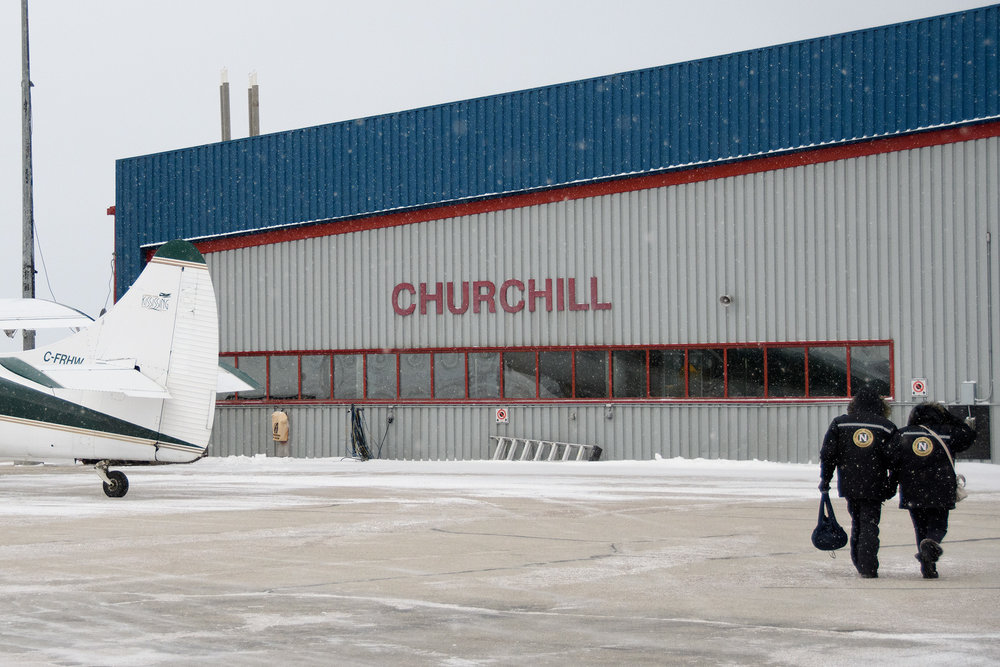
Arriving at the Churchill airport. Jeff Klofft photo.
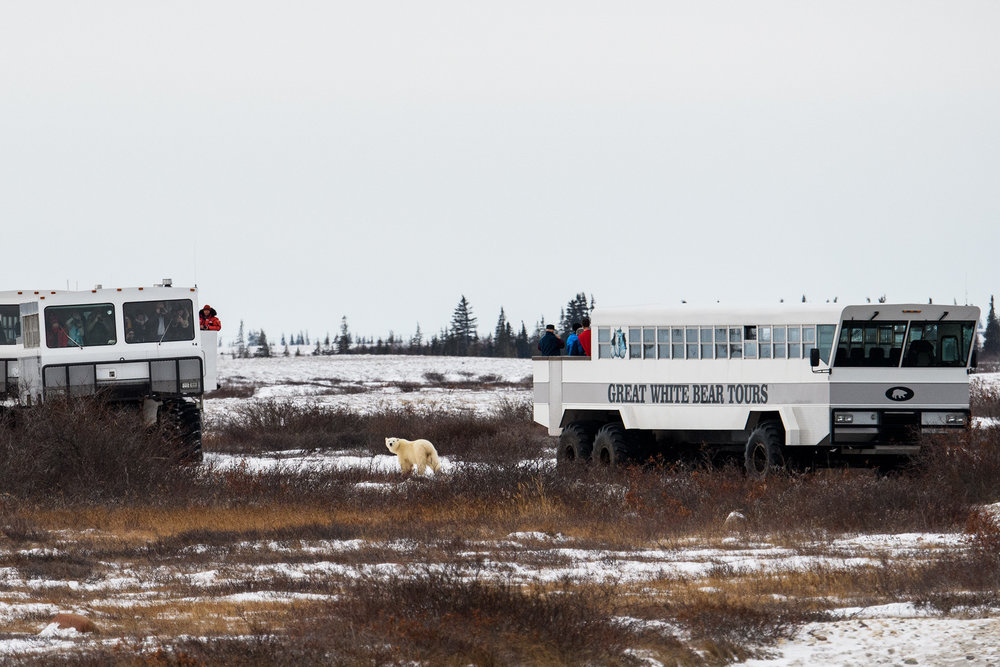
Polar bear viewing from Great White Bear’s polar rovers. Jeff Klofft photo.
So if going it alone sounds complicated, there are several full service tour companies that offer packages that include transportation, lodging and daily activities to see bears and learn more about the culture and people of Churchill. We chose to travel with Natural Habitat Adventures (click here) They use some of the same outfitters you would use if you book your own trip, (and you might find, they’ve already booked most of the lodging for their guests) We were very happy with our Nat Hab trip because of their excellent guiding, partnership with the World Wildlife Federation, and the addition of unique opportunities to learn more about the culture and people of the north. But we mostly chose Nat Hab because they handle all the details of the trip for their guests, in an environment where “smooth” isn’t even used to describe the ice on Hudson Bay! Between the weather, food arriving only occasionally by train and a busy, short tourist season in a village with only a few services like restaurants and hotels, it was nice to have someone else handling all the details. The weather alone can cause itinerary changes almost hourly, and our Natural Habitat Guide, Katie, handled them all with her cell phone and a smile, and communicated them well to our group, while we relaxed and enjoyed the scenery!
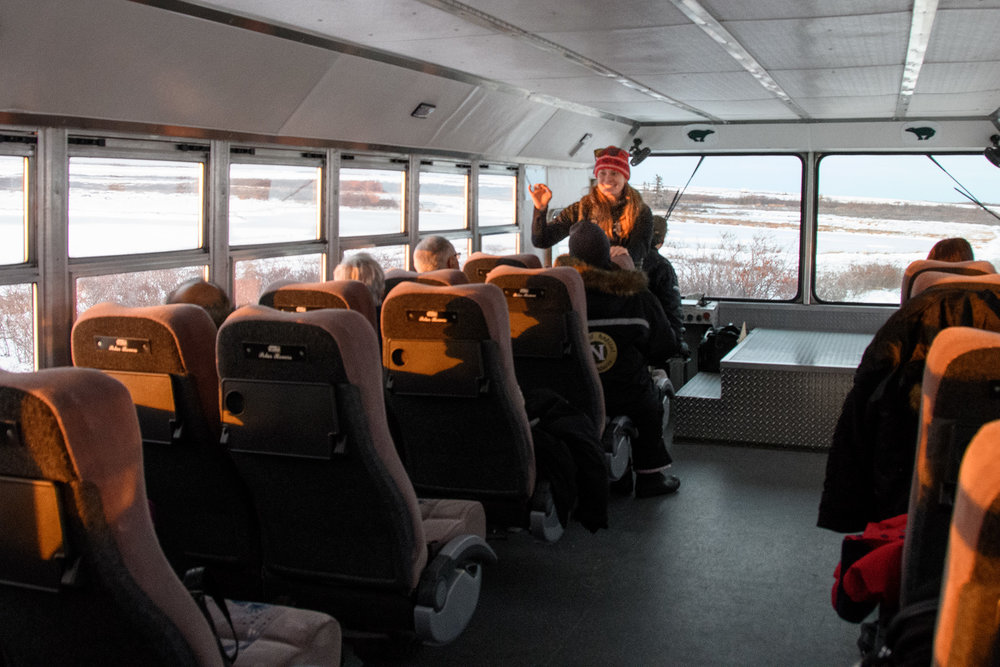
Natural Habitat small group experience. Jeff Klofft photo.
Although it was a “group tour”; and nature people generally avoid “groups”; our group of 16 had our own polar rover, which could have easily held twice our group, so everyone had their own window seat and a seat next to them for gear. Had we gone alone, we would have shared the rover with a much larger group vying for space on the outdoor platform and at the windows. The food served was excellent, and I didn’t realize how challenging that must have been until I toured the Northern department store in Churchill and saw that the whole produce section could have fit in my carry on bag! The prices were also shocking, making me appreciate how difficult it must be for local people to fill their fridges! It was a splurge to travel with Natural Habitat, as most safaris in remote areas are, but the testament to whether it’s “worth it” was hearing from one couple in our group who was on their 5th trip to Churchill, and even though they were very familiar with the area and had planned their first couple of trips independently, they choose to return with Natural Habitat for last few because they felt the experience offered was worth the expense.
(As far as budget planning- when planning all inclusive guided safaris in the wilderness just about anywhere in the world, I have found I need to budget $500- $1000 per person per day. I will often compromise on the length of a nature trip rather than miss a peak wildlife experience by going at a cheaper time and missing the natural phenomena I came to see!)
by Steve Selden | Jan 23, 2017 | Tour News
Before northern lights season starts we wanted to post this blog series from Kathy and Jeff Klofft from Boston. The couple joined Natural Habitat Adventures last fall on a polar bear trip to Churchill and documented the trip in a blog by Kathy and some awesome photos from Jeff. Their blog site is Go See It Travel documenting their adventures around the USA and world. These next few days we will publish their account of Churchill as well as lots of photos from the experience! Enjoy.
Polar Bears of Churchill, Manitoba, Canada
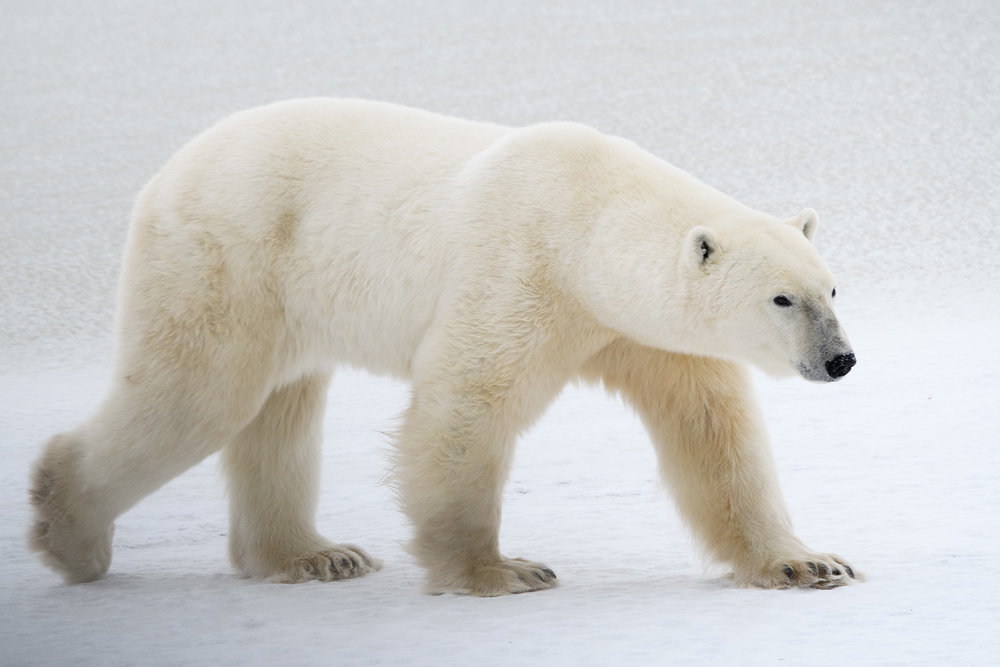
Polar bear on the Churchill tundra. Jeff Klofft photo.
There are only a few places in the world to see polar bears in the wild. This opportunity is further restricted by the fact that generally solitary polar bears have a huge territory range for most of the year and most live year round out on polar ice that is virtually inaccessible to human beings. The bears eat primarily seals, hauling them out of their breathing holes in the ice with their enormous paws. Some of the bears living furthest south, such as the population near Churchill have to move to land for a few months when the ice melts each summer. One place where polar bears can be seen is in Churchill Manitoba in the Wapusk National Park in Manitoba, Canada. The park area was created on the shores of Hudson Bay, where polar bears wait for the ice in Hudson Bay to freeze each fall. The bears don’t eat during the summer, spreading out in Northern Canada or denning up to give birth to cubs, and are just waiting for the ice to form again, so they can go back out hunting.
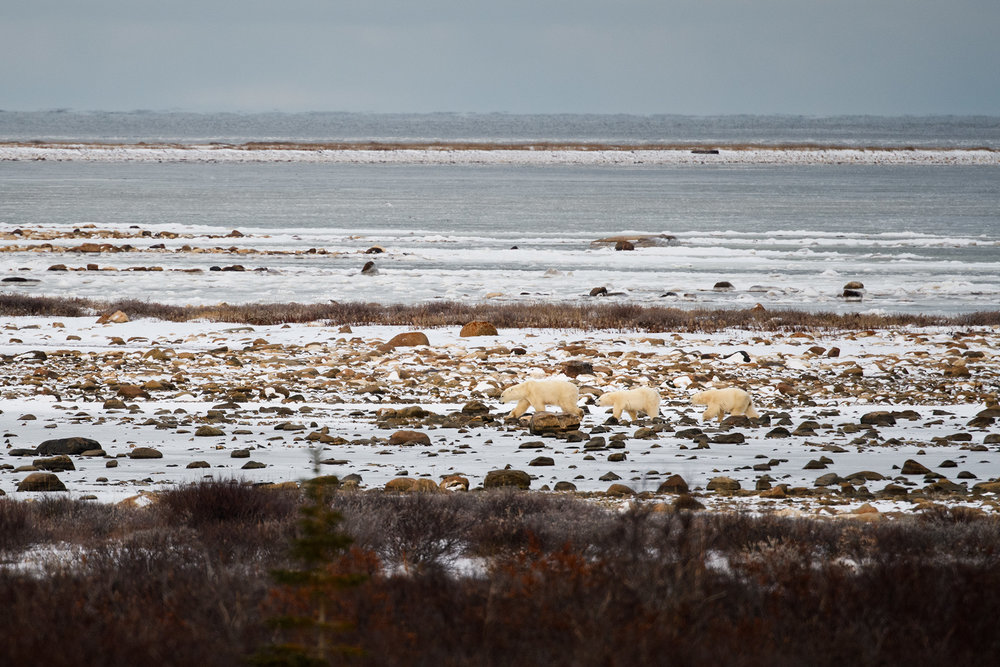
A mother and her cubs wait for the ice to freeze on Hudson Bay to begin hunting seals. Jeff Kloft photo.
With a helicopter (like the researchers use) or lots of time living in bear country, a human might have an encounter with a bear during the 8 months, or so of the year that the bears are on ice, but most chances for bear and human encounters in Churchill will be in the late fall, mid October to mid November, when the bears start to literally lie on the shores waiting for the ice to from. Watching the bears on the shore waiting reminded me of this adaptation of a phrase about boiling water…”a watched bay never freezes!” But their month long wait on the shores of the Hudson Bay also provides a chance for human/bear encounters.
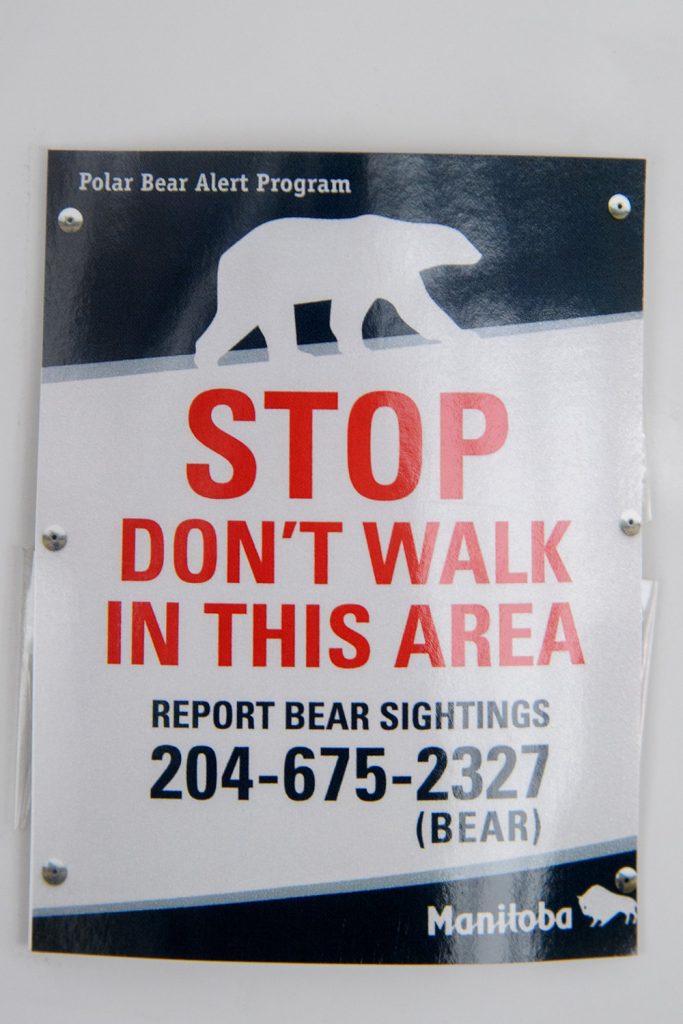
Polar bear warning sign in Churchill. Jeff Klofft photo.
For most of human history, polar bear/human encounters consisted of bears being hunted by Inuit people who used every part of the bear for survival, or dangerous encounters where bears sought human food or sled dogs and had to be destroyed to protect people and property. We learned from our guides that governments who operate in polar bear range states joined together to make agreements which would allow traditional hunting for people who rely on polar bears for survival, but protect them commercial hunting, which was decimating the numbers of polar bears in the wild. Since then, efforts were made to ensure bear/human conflicts could be avoided. Polar bear tourism was developed to happen only in the safest ways for both humans and bears. During our trip we heard from Elizabeth Kruger, World Wildlife Federation Arctic and Bering Sea Program Officer, that local residents have been empowered and trained to use bear patrols to redirect bears from populated areas, and local activists have changed garbage handling methods to discourage them from seeking human food. Our polar rover driver described that growing up in Churchill, the family would go out to the dump to see bears. Today, creative handling and containment of garbage have eliminated the bears at the dump and they roam where they belong, in the tundra. In Canada concessions were given to allow operators to allow polar bear tourism in the safest possible way.
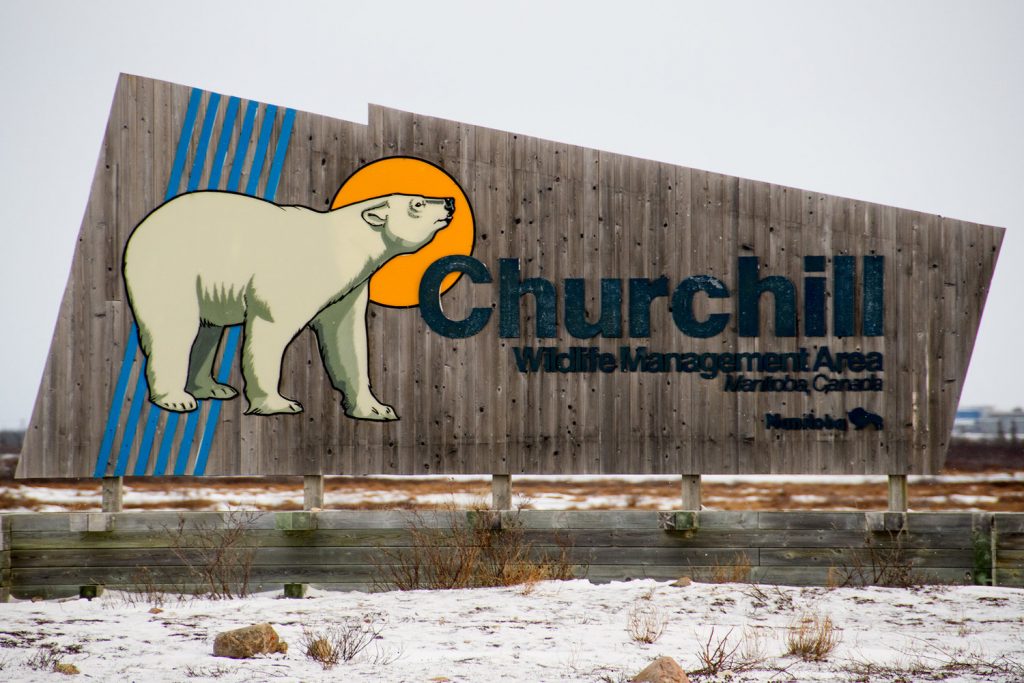
Welcome to Churchill sign on the outskirts of town. Jeff Klofft photo.
So…bears are being conserved, but there are only a few weeks a year in Churchill when it’s practical to see polar bears, and the location to find them is still very remote…so how do you “go see it”?!
Tomorrow we will post more of the blog and answer the question above.
by Steve Selden | Dec 14, 2016 | Churchill Photography
A late season necessitated more polar bear lifts than usual as Churchill and the surrounding area was inundated with the majestic animals. It looks like the season has finally come to a close with winter weather settling in and the Hudson Bay ice pack finally land – fast against the coast. Good news for polar bears as they are now able to begin replenishing their fat storage through seal – hunting! Hopes are high that the late start will bring a bounty of seals for hungry polar bears and the spring thaw will happen later than usual.
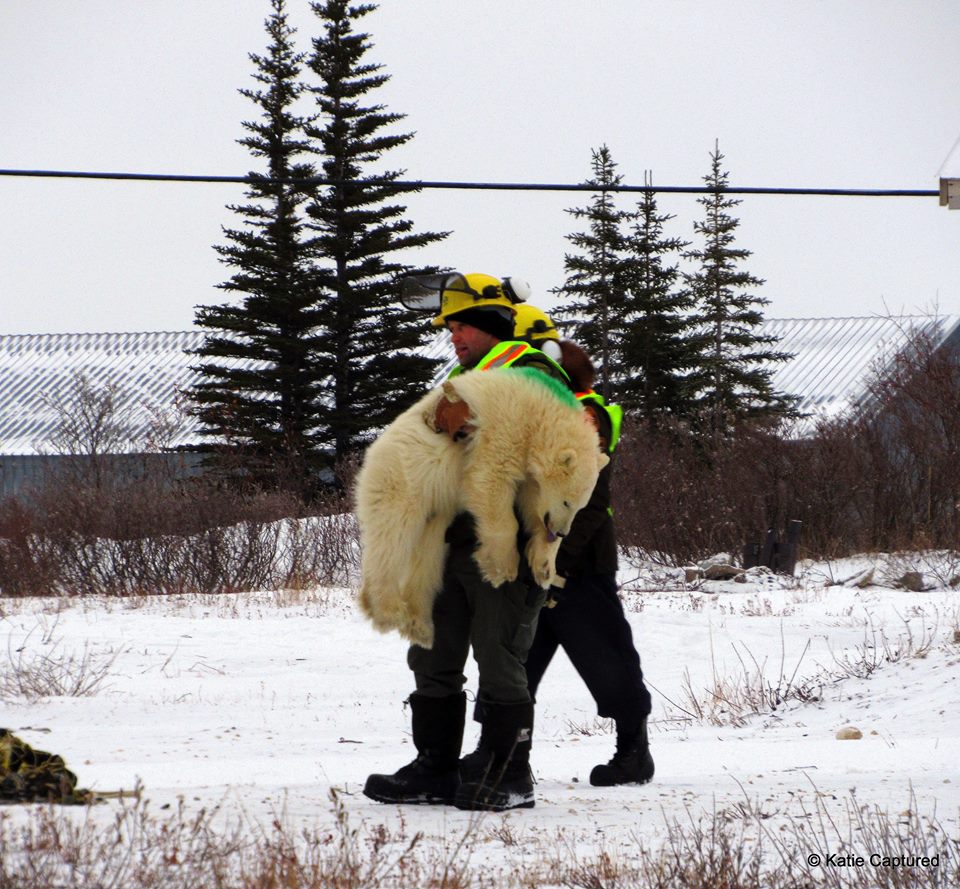
Manitoba Conservation officers ready a polar bear for a lift north. Katie de Meulles photo.















